| Athena Review Vol.1, no.3
| | |
First Voyage of Columbus: Meeting the Islanders (1492) | | | | |
|
Christopher
Columbus had read the journals of Marco Polo, the famed Venetian
merchant who travelled to China in 1170-1190 and told of Cipangu
(Japan) and thousands of other populated islands. When Columbus sailed
west from the Canaries in 1492, he fully expected to reach these
islands in the China Sea. Instead he reached the Bahamas, and met its
inhabitants, the Taino.
Sources: Two accounts exist from the
first voyage. One, a letter written by Columbus on the return trip for
Queen Isabella and King Ferdinand of Spain, was printed in 1493, with
15 more editions in the next five years. The second primary source is
the logbook or Journal kept by Columbus, presented in 1493 to the
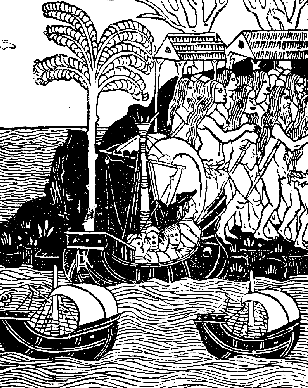 Spanish monarchs. A summary of the log was written by Columbus's son
Ferdinand. The manuscript eventually passed to a Dominican monastery in
Seville, where friar Bartolomé de las Casas used it for his Historia de
las Indias, published in 1558. Since the original and all known
copies later disappeared, the summaries by las Casas and Ferdinand
remain the only extant sources of Columbus' Journal. Spanish monarchs. A summary of the log was written by Columbus's son
Ferdinand. The manuscript eventually passed to a Dominican monastery in
Seville, where friar Bartolomé de las Casas used it for his Historia de
las Indias, published in 1558. Since the original and all known
copies later disappeared, the summaries by las Casas and Ferdinand
remain the only extant sources of Columbus' Journal.
Fig.1: Columbus meeting the Taino on Hispaniola. Letter, 1493.
The
Spaniards first encountered the Arawakan-speaking Taino in the
southeast Bahamas. These island were called the Lucayos (Leeward
Islets) by the Spanish, and the local Arawakan dialect is named Lucayan.
Columbus
left Palos, Spain with the three ships Santa Maria, Niña, and Pinta on
August 3, 1492, passing Cadiz a few days later on the way to the Canary
Islands. On September 6, after repairing the Pinta's rudder, they
headed due west from the Canaries along latitude 28º N to find a direct
passage to Japan and the East Indies. Crossing the seaweed-filled
Sargasso Sea on September 16-29, they made several false sightings of
land.
Guanahaní (San Salvador or Watling):
On October 8, ducks and other land birds were observed flying southwest
(box), and Columbus changed course. At 2 AM on October 12, crewmen from
the Pinta sighted land in the Bahamas at latitude 24º N (fig.2). The
next morning, as Columbus reports in the 1493 Letter, " On the
thirty-third day after I departed Cadiz, I came to the Indian sea,
where I found many islands inhabited by men without number... To the
first of these I gave the name of the blessed Saviour [San Salvador]...
But the Indians call it Guanahaní..." [Taino for "iguana"]
The
Taino islanders arrived in large numbers with cotton, parrots, and
spears to trade with the Spaniards: " Presently many inhabitants of the
island assembled... That we might form great friendship, ... I gave to
some of them red caps, and glass beads to put round their necks, and
many other things of little value, which gave them great pleasure, and
made them so much our friends it was a marvel to see. They afterwards
came to the ship's boats... bringing us parrots, cotton threads in
skeins, spears, and many other things; and we exchanged them for...
glass beads and small bells. "[Journal, Oct. 12, 1492]
Columbus
notes the appearance of the Taino, and their use of body paint: " They
go as naked as when their mothers bore them, and so do the women,
although I did not see more than one young girl. All I saw were young
men, none more than 30 years of age. They are very well made, with very
handsome bodies, and very good countenances. Their hair is short and
coarse... down to the eyebrows, except a few locks behind, which they
wear long and never cut. Some paint themselves white, others red, and
others of what color they find. Some paint their faces, others the
whole body, some only round the eyes, others only on the nose.
"[Journal, Oct. 12, 1492]
Some of the Taino wore gold ornaments,
in which the Spaniards took much interest " I saw that some of them had
a small piece [of gold] fastened in... the nose, and by signs I was
able to make out that to the south... there was a king who... possessed
a great quantity. "[Journal, Oct. 13, 1492]
Columbus soon learned that the Taino of Guanahaní had enemies on other islands called the Caniba
(Caribs): " I saw some with marks of wounds on their bodies, and I made
signs to ask what it was, and they [told] me that people from other
adjacent islands came with the intention of seizing them, and that they
defended themselves. I believe... that they come here from the mainland
to take them prisoners." [Journal, Oct. 12, 1492]
The Taino
lacked iron and used spears with sharpened wood or bone tips: " They
neither carry nor know anything of arms, for I showed them swords, and
they took them by the blade and cut themselves through ignorance. They
have no iron, their darts [short spears] being wands without iron, some
of them having a fish's hook at the end, and others being pointed in
various ways. "[Journal, Oct. 12, 1492]
The Islanders had dugout
canoes, similar to those later illustrated by Oviedo and other
chroniclers: "They came to the ship in small canoes, made out of the
trunk of a tree like a long boat, and all of one piece, and wonderfully
worked... They are large, some of them holding 40 to 45 men, others
smaller, and some only large enough to hold one man. They are propelled
with a paddle like a baker's shovel, and go at a marvelous rate...
" [Journal, Oct. 13, 1492]
Rum Cay:
Leaving Guanahaní with native guides aboard on October 15, the Spanish
ships passed Rum Cay which they named Santa Maria de la Concepción.
They encountered a single man in a canoe with trade goods already
including some Spanish-made items, going from Santa Maria to Fernandina
(Long Island): "He had a l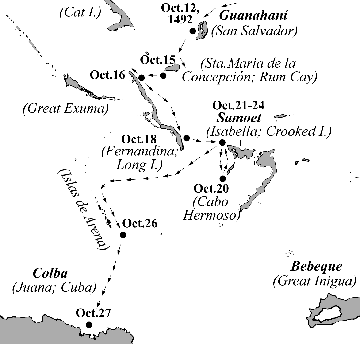 ittle of their bread, about the size of
a fist, a calabash of water, a piece of brown earth [pigment] powdered
and then kneaded, and some dried leaves [probably tobacco], which must
be a thing highly valued by them, for they bartered with it at San
Salvador. He also carried with him a basket of their make, in which he
had a string of glass beads and two blancas [copper coins], [showing]
he came from...San Salvador...".[Journal, Oct. 15, 1492] ittle of their bread, about the size of
a fist, a calabash of water, a piece of brown earth [pigment] powdered
and then kneaded, and some dried leaves [probably tobacco], which must
be a thing highly valued by them, for they bartered with it at San
Salvador. He also carried with him a basket of their make, in which he
had a string of glass beads and two blancas [copper coins], [showing]
he came from...San Salvador...".[Journal, Oct. 15, 1492]
Fig.2: Map of the first two weeks of Columbus' first voyage in the Caribbean (after Morison 1942).
Fernandina:
The next four days (Oct.16-19) were spent at Fernandina, where Columbus
saw more of the trading skill of the natives: " These people are like
those of [San Salvador], and have the same speech and manners, except
that these here seem to be somewhat more domesticated and tractable,
and more intelligent... [because] they know better how to bargain than
the others did." [Journal, Oct. 16, 1492]
Here Columbus also saw
dogs and other aspects of daily life such as houses (fig.3), hammocks,
clothing, and personal ornaments:"...Their beds and coverings are like
nets of cotton... The houses are all like tents and very high and with
good chimneys, but... I have not seen... [a village] of more than...
twelve to fifteen  houses. Here they found that married women wore
cotton drawers, but girls do not, except some who were already eighteen
years old. There are here mastiffs and small dogs, and here they found
a man who had in his nose a piece of gold, which might have been half
the size of a castellano..." [Journal, Oct. 17, 1492] houses. Here they found that married women wore
cotton drawers, but girls do not, except some who were already eighteen
years old. There are here mastiffs and small dogs, and here they found
a man who had in his nose a piece of gold, which might have been half
the size of a castellano..." [Journal, Oct. 17, 1492]
Fig.3: Native house in Hispaniola (Oviedo 1547)
Samoet (Isabella, now Crooked Island):
A short distance east was the island called Samoet where the Spaniards
anchored from October 20-24, 1492: "There [came] many... [as on] the
other islands, just as naked and just as painted... They brought spears
and some skeins of cotton to exchange, and they bartered these with
some sailors for bits of glass from broken cups and for bits of
earthenware. Some of them wore some pieces of gold, hanging from the
nose, and they gladly gave these for a hawks' bell, of the kind made
for the foot of a sparrow-hawk, and for glass beads..." [Journal, Oct.
22, 1492]. Morison (1942) notes that Columbus carried the standard
trade goods used by the Portuguese in West Africa: Venetian glass
beads, red caps, and small round bells called hawks' bells, used in
falconry.
Colba (Juana, now Cuba):
After briefly sailing west, on Oct. 25-26 they ran into shoals (the
Islas de Arena), and turned south. On Oct. 27, Cuba was sighted and the
Spaniards spent five weeks (Oct.28-Nov.5, 1492) along its northeast
coast. "As soon as we had arrived at... Juana... I proceeded [west]
along its coast... for some distance... seeing however, no towns or
cities situated on the seacoast, but only some villages and rude farms,
with whose inhabitants I was unable to converse, because... they took
flight. "[Letter, 1493]
Columbus' first Cuban landing was at
Bahia Bariay, near a fishing camp: "The Admiral jumped into the boat
and went to shore, and he came to two houses, which he believed to be
those of fishermen who fled from terror. In one of them he found a
[kind of] dog that never barked, and in both houses he found nets of
palm-fibre and lines and horn fish hooks, and bone harpoons, and other
fishing-tackle, and many fires in the houses... In each one of the
houses many persons lived together." [Journal, Oct. 28, 1492]
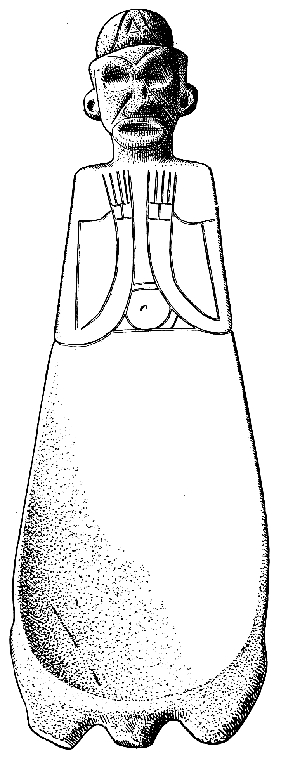 Next
day Columbus visited río de Mares (Puerto Gibara), where he found more
large houses containing furniture, wooden carvings, and tame birds.
"[The houses] looked like tents in a camp, with no regular streets, but
one here and another there. Inside, they were well swept and clean, and
their furnishing...[was] made of very beautiful palm branches... There
were wild birds, tamed, in their houses... They found many images made
like women, and many heads like masks, very well worked. He did not
know if they had them for their beauty or whether they worshipped
them." [Journal, Oct. 29, 1492] Next
day Columbus visited río de Mares (Puerto Gibara), where he found more
large houses containing furniture, wooden carvings, and tame birds.
"[The houses] looked like tents in a camp, with no regular streets, but
one here and another there. Inside, they were well swept and clean, and
their furnishing...[was] made of very beautiful palm branches... There
were wild birds, tamed, in their houses... They found many images made
like women, and many heads like masks, very well worked. He did not
know if they had them for their beauty or whether they worshipped
them." [Journal, Oct. 29, 1492]
Ferdinand's
account provides a valuable description of duhos (fig.4), carved seats found in
Taino cacique houses: "They seated each in a chair made of one piece
and in a strange shape, for it resembled some short-legged animal with
a tail as broad as the seat of the chair [which] had a head in front
with eyes and ears of gold. They call these seats duhos." [Arrom 1988]
Fig.4: Stone duho, or carved seat with effigy head, from the West Indies (Fewkes 1922; Berlin Museum.)
After
fanciful descriptions by his native guides of western Cuba, Columbus
decided to turn back east. " There are two more provinces in that part
[of Cuba] which lies towards the west, which I did not visit; one of
these the Indians call Anan, whose inhabitants are born with
tails... [perhaps the Ciboney, who occupied cave sites; Letter,
1493]
Columbus returned to río de Mares for the next twelve days
(Nov. 1 - 12, 1492): "...presently there came to the ships more than
sixteen boats or canoes, with spun cotton and their other trifles, of
which the admiral commanded that nothing should be taken, in order that
they might know that the admiral sought nothing except gold, which they
call nucay... "[Journal, Nov. 1, 1492]
Columbus failed to find
any gold on Cuba, although a silver nose ring ornament was seen, the
only mention of silver on this voyage. The next day, still
believing they were near Cipangu (Japan), Columbus sent two of his men
inland with Taino guides to search for the local chief and sources of
spice. They returned in four days, after "... [marching] twelve
leagues, [to] a village of fifty large wooden huts, thatched with
palms, and shaped like tents or pavillions... There must have been as
many as a thousand families in that village, because all the people of
the same kindred live in a single house... The principal men of that
country came out to meet them, and carried them on their shoulders to
the village... " [Ferdinand Columbus, ch.5]
Finding no large
towns, and returning to the ships, the Spaniards saw many people "...on
their way to their villages, men and women, with a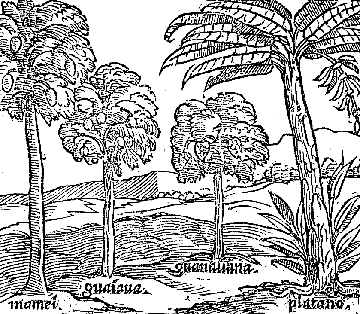 brand in their
hands, the herbs for smoking which they are in a habit of using."
[Journal, Nov. 6, 1492].With this (the first historical mention of
tobacco smoking), Columbus also notes other plants cultivated at río de
Mares: "...these lands are very fertile; they are full of mames (fig.5) which
are like carrots and have the flavor of chestnuts; and they have beans
and kidney beans very different from ours and much cotton, which they
do not sow... " [Journal, Nov. 4, 1492] brand in their
hands, the herbs for smoking which they are in a habit of using."
[Journal, Nov. 6, 1492].With this (the first historical mention of
tobacco smoking), Columbus also notes other plants cultivated at río de
Mares: "...these lands are very fertile; they are full of mames (fig.5) which
are like carrots and have the flavor of chestnuts; and they have beans
and kidney beans very different from ours and much cotton, which they
do not sow... " [Journal, Nov. 4, 1492]
Fig.5: Fruit-bearing trees of Hispaniola, including the mamey (Mammea americana), guava (Psidium guajaba), guanabana (Annona muricata), and the plantain or banana (Musa sp.) (Benzoni 1572).
He also encountered natives who claimed cinnamon and gold could be found at a place to the southeast called Bohío (Hispaniola; now Haiti and the Dominican Republic). Bohío,
Taino for the rectangular houses of the nobles, also meant home country
(Morison 1942). There, as the Cubans claimed, "...they wore [gold]
round their neck and on the ears and legs, and also pearls... [and]
there were large ships and merchandise..".
From the Taino on
Cuba Columbus also heard about hostile Caribs on Bohío: "...far from
there were men with one eye, and others with dogs' noses who ate
men..". [Journal, Nov. 4, 1492]. " All the people who have been found
up to this time have... the very greatest fear of those of Caniba or Canima
[Caribs] and they say that they live in the island of Bohío which must
be very large, as it appears, and he believes that those of Caniba take
these people... from their lands and houses. " [Journal, Nov. 26, 1492]
Although
Columbus did not encounter Caribs on this voyage, he conveyed reports
from Dominica, a Leeward Island later visited on the second voyage:
"This island [Dominica] is inhabited by a certain people who are
considered very warlike by their neighbors. They eat human flesh. The
said people have many kinds of row-boats, in which they cross over to
all the other Indian islands, and seize and carry away every thing that
they can. They differ in no way from the others, only that they wear
long hair like the women. They use bows and darts made of reeds, with
sharpened shafts fastened to the larger end, as we have described. On
this account they are considered warlike, wherefore the other Indians
are afflicted with continual fear..". [Letter, 1493]
Departing
río de Mares on November 12, Columbus set out for an island called
Babeque (Great Inigua) where: "...the people... gather gold on the
shore at night with candles, and...with a mallet they make bars of it.
"[Journal, Nov. 12, 1492]. Unfavorable winds kept Columbus from
Babeque, although on November 22 Martin Alonso Pinzón broke away in the
Pinta and sailed (against orders) for this place of alleged gold. The
Pinta was not seen again until January 6, 1493. Columbus, meanwhile,
sailed around the northeast coast of Cuba for the rest of November,
observing that the local Taino " ...carry for weapons... reeds
baked in the sun, on the lower ends of which they fasten some shafts of
dried wood rubbed down to a point... [though] it frequently happened
when I sent two or three of my men to some of the villages, that...
they would quickly take flight... not because any hurt or injury had
been inflicted on any one of them... but they are by nature fearful and
timid." [Letter, 1493]
Evidence
for long distance trade by the Taino included beeswax found in one
house on Cuba (thought to come from the Yucatec Maya who practiced
beekeeping), and a variety of sea-going canoes: "...On every island
there are many canoes... with which they cross to all those islands,
which are innumerable, and with these boats they perform their trading,
and carry on commerce among them. I saw some of these... canoes which
were carrying seventy and eighty rowers. [Letter, 1493]
Further
explorations in Cuba found ritual use of human heads in nearly deserted
Taino villages. These were interpreted by Columbus as due to ancestor
worship. " The sailors also found in one house a man's head in a small
basket [jaba], covered with
another basket, and hanging to a post of the house. They found another
of the same kind in another village. The admiral believed that they
must be the heads of some principal ancestors, because those houses
were of a kind so that many persons find shelter in one house, and they
could only be relations, descendants of one common ancestor. " [Journal, Nov. 29, 1492]. According to Rouse and Arrom (1992), Columbus' interpretation seems accurate.
Bohío (Española):
Reaching Cuba's eastern end on December 5, Columbus again started north
for Babeque, but seeing the island of Bohío off to the east, he
followed more favorable winds to this large island, which they called
Española (Hispaniola). There they remained for a month until January 6,
1493. On December 5, when the Niña anchored at Puerto Saint Nicholas.
"Many fires were seen that night, and by day much smoke as if from
lookouts, which seemed to be designed to guard against some people with
whom they were at war..." [i.e. the Caribs]. [Journal, Dec. 6, 1492]
Columbus
was impressed by the country's fertility. In the harbor mouth was "...
a field of trees of a thousand kinds, all laden with fruit... believed
to be spices and nutmegs... Opposite the harbor there was a beautiful
fertile plain and in the middle of it [a] river, and... in this
neighborhood there must be large centers of population... [but] the
Indians took to flight and fled when they saw the ships." [Journal, Dec. 6, 1492]
The
Spaniards sat at anchor through heavy weather from December 8-10.
Believing there were villages, Columbus "...sent six men...two or three
leagues inland, in order to discover if they could have speech. They
went and returned, having found [only] some huts and very wide roads,
and places where many people had made fires. "[Journal, Dec. 10,
1492]. On December 12, a larger group of natives were
encountered, and fled except for a young woman who was brought back to
the ship. Speaking the same language as the Cuban Taino, she had a
small piece of gold in her nose and seemed to be a member of the
nobility. Columbus gave her clothing and sent her back to her people.
Next
day, when Spaniards went to her town they found it momentarily
deserted. The villagers returned, however, when a Taino interpreter
reassured them that the Spaniards were not Caribs. "When at last they
had lost their fear, they... brought what they had to eat, which was
bread of niames [yams] that
is roots like large 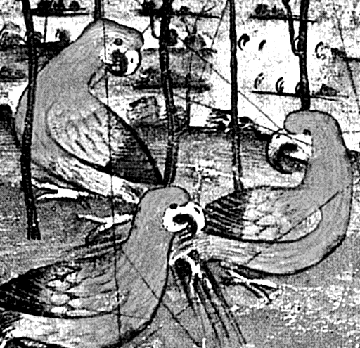 carrots which they grow... their mainstay of life.
They make bread from these roots and boil and roast them, and they
taste like chestnuts... They gave... bread and fish and whatever they
had. And as [they] had understood that the admiral wished to have a
parrot ... they brought them parrots and gave them as many as they
asked. "[Journal, Dec. 13, 1492]. The high ranking girl they had met
the previous night appeared borne on the shoulders of retainers to give
thanks for the gifts. Columbus' men had high praise for these villagers
and for the land's fertility. carrots which they grow... their mainstay of life.
They make bread from these roots and boil and roast them, and they
taste like chestnuts... They gave... bread and fish and whatever they
had. And as [they] had understood that the admiral wished to have a
parrot ... they brought them parrots and gave them as many as they
asked. "[Journal, Dec. 13, 1492]. The high ranking girl they had met
the previous night appeared borne on the shoulders of retainers to give
thanks for the gifts. Columbus' men had high praise for these villagers
and for the land's fertility.
Fig.6: New World parrots, from the 1502 Cantino Map.
Columbus
sailed towards Tortuga Island on December 15, returning to the coast of
Haiti later that day. He landed at Valle de Paraiso (Paradise Valley),
from which flowed the river Guadalquivir (today, Trois-Rivières). The
next morning, Columbus found an Indian in a canoe, and "...had him and
his canoe taken aboard the ship, and... gave him glass beads, hawks'
bells and brass rings, and carried him in the ship [to] a village...16
miles from there near the sea..." [Journal, Dec. 16, 1492]
Soon
over 500 men had assembled by the ship, many eager to trade bits of
gold worn in their ears or noses. In hopes of more gold, Columbus
remained there (Cabo de Elefantes) for several days. The young chief of
the island arrived borne on a litter accompanied by over 200 men, to
dine on board with Columbus, exchanging gold for cloth, amber beads,
and red shoes. After the chief departed, his brother arrived and told
Columbus that "...in their language they called the king cacique...[and
that] there were many islands near... in which very much gold was
produced... so great a quantity that they gather it and sift it with
sieves, and they smelt it and make bars and a thousand worked
articles.." [Journal, Dec. 18, 1492]
On December 20, Columbus landed at Acul Bay. Islanders came, "...some [running] to bring us the bread they make of niames [yams], which they call ajes...
and they brought us water in gourds and clay pitchers... They did all
this with such generosity of heart and such joy that it was
wonderful... for they did the same and as freely when they gave pieces
of gold as when they gave a gourd of water..." [Journal, Dec. 21, 1492]
On
December 22, a chief invited Columbus to visit his island, sending a
large canoe of men and a mask with beaten gold ears, tongue, and nose.
Columbus sent six men, led by his secretary "...so he might prevent the
others doing anything unjust to the Indians. For the Indians were so
liberal and the Spaniards so greedy and unrestrained... [that] the
admiral ordered that nothing should be accepted from them without
something being given in exchange." [Journal,
Dec. 22, 1492]. That same day, the ship was visited by more than 120
canoes full of people, bringing gifts of bread, fish, and seeds. Some
men went ashore to a village " ...better laid out in streets than any
of those previously found... [canoes] went ahead to give news to the cacique,
as they call him there. Up to that time the admiral had not been able
to understand whether by this they meant 'king' or 'governor.' They
also use another name for a 'grandee,' whom they call nitayno... [Journal, Dec. 23, 1492]. As confirmed by Friar Pané, later appointed by Columbus to record Taino customs, the word nitaíno is the source of Taino, name of the island culture.
The
cacique gave food and cotton cloths like those worn by women, parrots
for the admiral, and pieces of gold. Before sunrise on Christmas Eve,
Columbus set sail for a land described by an Indian visitor the
previous day: "...they spoke of Cipangu, which they call Cibao,
[declaring] that there was a great quantity of gold there, and that the
cacique carries banners of beaten gold, but that it is very far to the
east. "[Journal, Dec. 24, 1492]. Thus Columbus continued to believe he was near the fabled land previously reported by Marco Polo.
Wreck of the Santa Maria:
Perhaps dreaming of Japan, Columbus slept at 11:00 PM on Christmas Eve
in calm seas, leaving the tiller to a ship's boy or gromet. By early
Christmas morning, however, currents had eased the Santa Maria onto a
reef. In a last attempt to lighten and save the ship, Columbus ordered
the mast cut, only running it further aground. The local cacique,
Guacanagarí, hurried from his village (near modern Caracol) offering
canoes to help unload the wrecked ship, and houses for Columbus' crew.
Next day, a native canoe came to trade gold for hawks' bells: "...they
called out and showed the pieces of gold, crying "chuque chuque,"
meaning hawks' bells, for they almost go crazy for them... they called
the admiral and asked him to have a hawk's bell kept until next day,
since they would bring him four pieces of gold as large as the hand." [Journal, Dec. 26, 1492]
Guacanagari
told more tales of the riches of Cibao, which Columbus still thought
was Cipangu (Japan). "The king ate in the caravel with the admiral...
and gave him a repast of two or three kinds of ajes and with them
shrimp and game, and other foods which they had, and some of their
bread which they call cacabi
[cassava made from yuca root].... The king now wore a shirt and gloves,
which the admiral had given him, and he rejoiced more over the gloves
than over anything which had been given to him... They brought the
admiral a large mask, which had great pieces of gold in the ears and
eyes and in other places... which the king himself placed on the
admiral's head... " [Journal, Dec. 26, 1492]
Villa de la Navidad:
In these apparently friendly environs, Columbus used supplies salvaged
from the Santa Maria to found a colony where he left 39 men, the rest
sailing on the Niña: "...to [this colony] we give the name of our Lord
of the Nativity [Villa de la Navidad]. And I commanded a fort to be
built there... in which I left as many men as seemed necessary, with
all kinds of arms, and plenty of food for more than a year." [Letter,
1493]. Columbus was confident that the fort would be safe from
the natives. Its ultimate fate, however, would also rest on the actions
of the colonists themselves.
Return to Spain:
On January 4, 1493, Columbus departed for Spain, two days later meeting
up again (after six weeks) with Pinzón and the Pinta. During a storm on
Feb.14, fearing all record of the discovery might be lost, Columbus
summarized his journal in the letter which has provided much of this
description.
.
|
|
| Main
index of Athena Review
Copyright © 2023 Rust Family Foundation
(All Rights Reserved). | | |
.
|